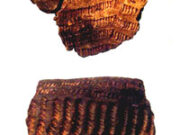Stallings Island, a National Historic Landmark site, was a major settlement of Late Archaic Native Americans from 4,500 to 3,500 years ago.
Located in the Savannah River eight miles upstream from Augusta, the sixteen-acre island is the namesake of Stallings Culture and its hallmark pottery, Stallings fiber-tempered wares, the oldest pottery in North America. Stallings Island was occupied intermittently throughout prehistory. It was during the height of Stallings Culture (ca. 3,800 to 3,500 years ago), however, that the site appears to have been the population center of a hunter-gatherer society whose level of culture was more complex than that of all prior societies in the surrounding region.
The most significant archaeological deposits on Stallings Island consist of a two-acre accumulation of freshwater shellfish remains—over ten-feet thick in places—along with other food remains, myriad artifacts, pit features, and human burials. Excavations began in the 1850s with investigations by Charles C. Jones Jr. They were followed in the twentieth century by no fewer than five expeditions, most notably the 1929 project sponsored by the Peabody Museum of Harvard University in Cambridge, Massachusetts. Illicit digging has been an ongoing cause of destruction at the site. The Archaeological Conservancy acquired Stallings Island in 1997 and strives to protect it from further damage.
Stallings Island is best known for its very early pottery, a technological development that predated the advent of farming in Georgia by several millennia. Accompanying this innovation were other indications, such as permanent architecture and storage technology, of an increasingly intensive hunter-gatherer economy. At 3,500 years ago the island and surrounding area were abandoned. Evidence for diminished health and environmental degradation suggest that the sedentary Stallings lifestyle ultimately was unsustainable. Changing relations with neighboring groups on the coast and in the uplands may have contributed to regional abandonment.




